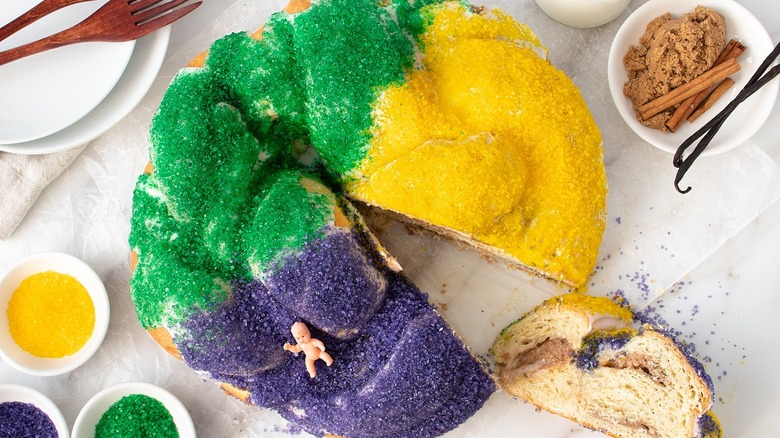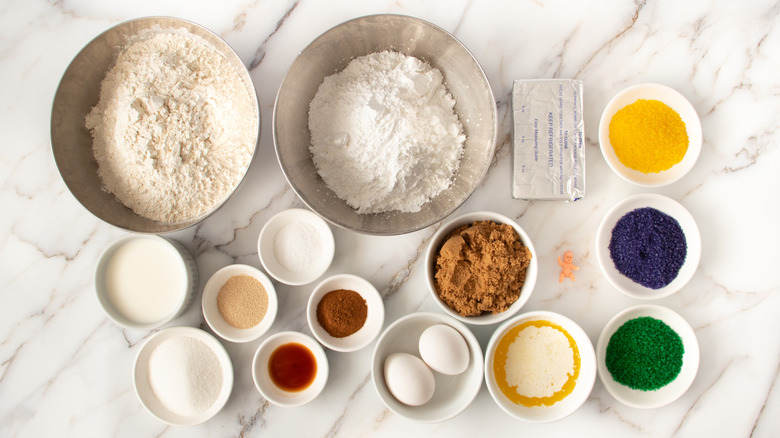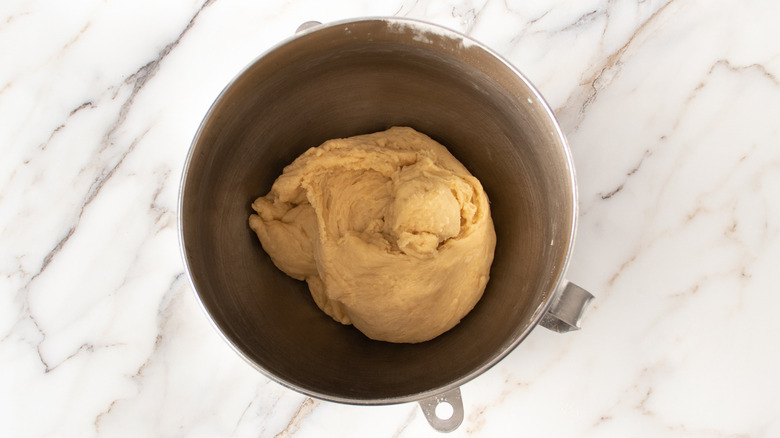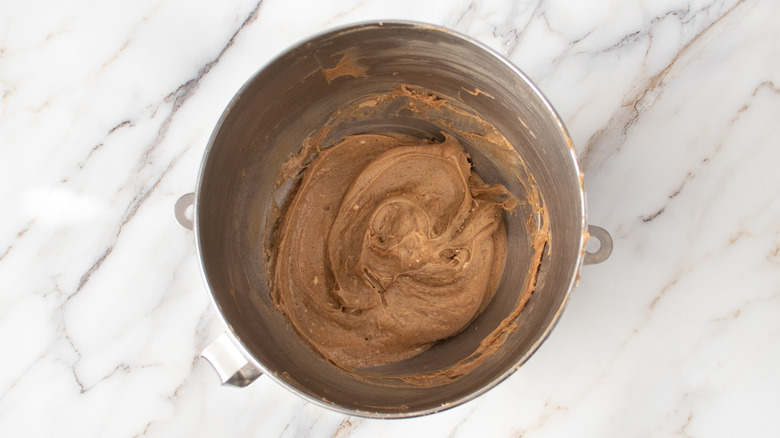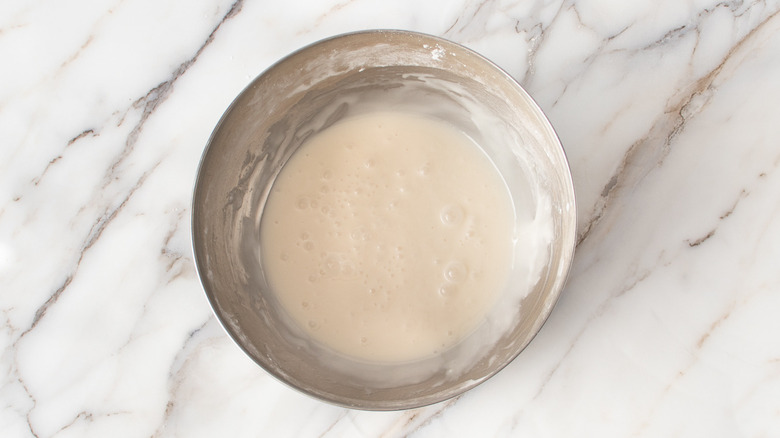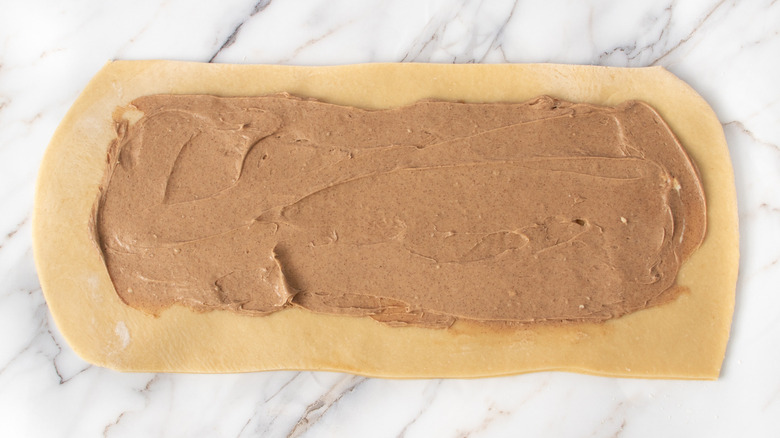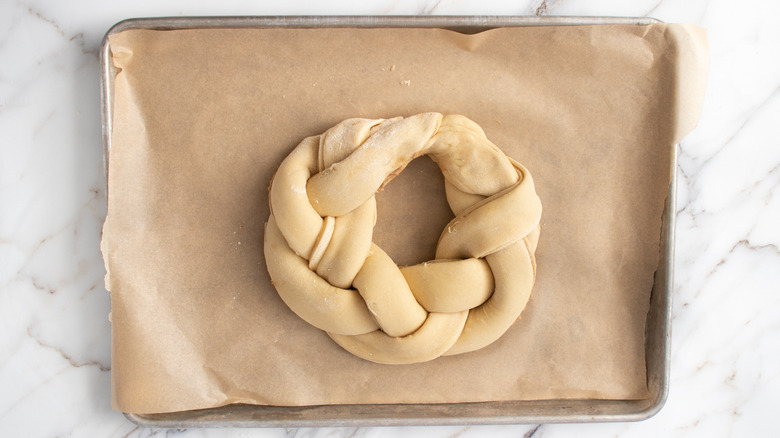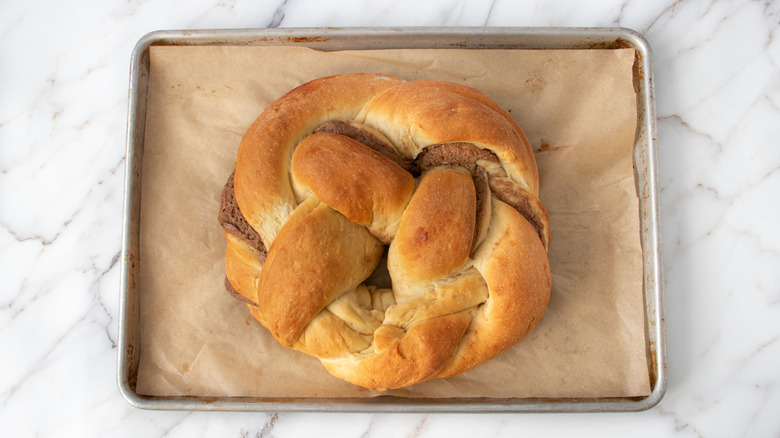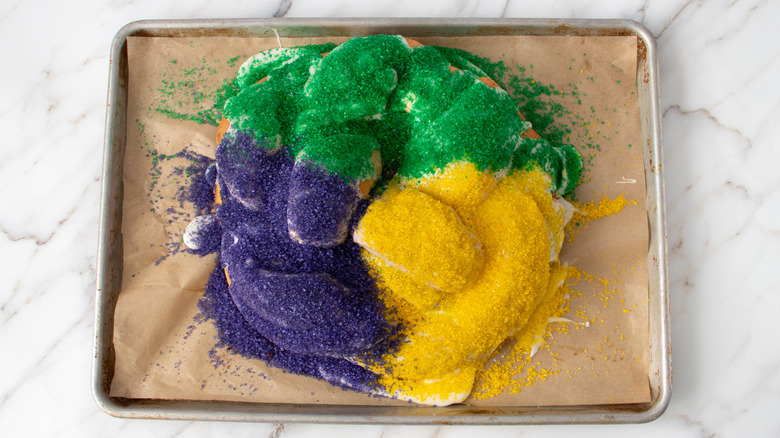Mardi Gras King Cake Recipe
Festivities call for sweet treats, and when the celebration in question is Mardi Gras, you can bet that there will be lots of color involved. Recipe developer Patterson Watkins explains, "This is a pretty straight-forward king cake recipe," noting that the dessert is closer to a "well-dressed sweet bread than an actual 'cake.'" Regardless, everything about this baked good calls for jubilation. As Watkins comments, "This recipe really puts you in a celebratory mood," adding that it "inspires lots of last-minute New Orleans flight searches with each slice."
Whether or not you make it to the heart of the festivities, this cake will bring the true Mardi Gras spirit to your table. Watkins explains that the baked tradition was first part of Christian Epiphany celebrations, spilling into carnival season. She elaborates, "The French brought the cake with them to Louisiana in the late 1800s and these 'royal' treats have been synonymous with Mardi Gras (Fat Tuesday) ever since."
With its vibrant colors, sweet brioche base, and cinnamon cream cheese swirl filling, you don't really need a calendar holiday to get inspired to make this cake. Read on for the step-by-step instructions.
Gather the ingredients for this Mardi Gras king cake
For this festive Mardi Gras king cake, you'll need whole milk, granulated white sugar, salt, all-purpose flour, instant yeast, eggs, butter (go ahead and melt it before you get cooking), and non-stick spray. As for the filling, stock up on dark brown sugar, ground cinnamon, and a package of cream cheese (just bring it to room temperature first).
The icing on the top is made with powdered sugar, whole milk, and vanilla extract. Finally, this cake needs a decorative flair; buy green, yellow, and purple sanding sugar, and if you have a little plastic baby figurine to finish it off, grab that too.
Combine the cake dough ingredients
To begin, you'll need to warm up some of the ingredients. Place a medium saucepan on the stovetop and pour in the milk, granulated sugar, and salt. Raise the heat to medium-low, whisking the contents to dissolve. Once the mixture's around 120 to 130 F, remove the saucepan from the heat.
Next, set up your stand mixer with the dough hook attachment and combine flour and yeast in the bowl. Slowly pour in the warm milk mixture as the mixer is running on low speed. The contents should begin to form a shaggy dough. When the milk is absorbed, add the eggs and pour in the melted butter, mixing for another 2 minutes or so until the ingredients are properly incorporated. Then, raise the speed to medium and begin to knead the dough for about 3 minutes until it starts pulling away from the sides of the bowl.
At this point, take the dough out of the bowl and roll it into a ball. Then, lightly grease a large bowl with non-stick spray and place the dough ball into it. Cover the bowl with some plastic wrap and leave it somewhere warm for about 1 hour while it rests and doubles in size. Watkins comments, "Patience is rewarded when making a king cake," and warns, "don't rush through the resting steps."
Make the cake filling
While you wait for the dough to rise, get the filling ingredients together. In your stand mixer bowl fitted with the whisk attachment, combine the brown sugar, cinnamon, and softened cream cheese. Once the mixture is smooth, cover it and set the bowl aside.
Prepare the icing
Next up, add the powdered sugar, 4 tablespoons of milk, and vanilla extract to a medium-sized bowl. Whisk the contents until they are well incorporated. The consistency should be thick enough to coat the backside of a spoon. However, if it is too thick, simply splash in an additional tablespoon of milk to thin it out. Once you've reached the desired texture, cover the icing and set it aside too.
Roll out the dough and spread the filling
When the dough has reached an adequate size, lightly dust a clean work surface. Place the dough on top and flatten and roll it into a 10x20-inch rectangle. Spread the filling uniformly across the surface, allowing for a 1-inch border around the perimeter.
Braid the dough and let it rise
Now comes the fun (and a little bit tricky) part: forming the intricate shape! Fold the dough in half along the long side of the rectangle and apply some pressure around the edges to seal it properly. Next, cut the rectangle into three long strips and braid them, alternating bringing the outer strips over the middle one.
Line a baking sheet with parchment paper and carefully place the braided dough over top. Shape the braid into a circle, pinching and twisting the two ends together to seal it closed. Then, cover the tray with plastic wrap and leave it to rest for another hour or until it doubles in size. Remember Watkins' advice to be patient!
Bake the king cake
When the dough is almost ready, preheat the oven to 350 F. Once the dough has doubled in size, place the tray in the hot oven and bake it for 25 to 30 minutes until the surface is golden brown. Transfer it to a wire rack to cool it down.
Ice and decorate the cake
When the cake is nice and cool, drizzle the icing over top in order to cover most of the surface. Watkins cautions, "you may be tempted to decorate your king cake right out of the oven," but explains that "a cooled cake will keep your decoration in place."
Once you've coated the cake with icing, sprinkle it liberally with the colored sanding sugar, dividing it into three sections with each color. Watkins highlights that the combination of icing and colorful Mardi Gras sprinkles (greens, yellows and purples) is just pure joy." If you have a little plastic baby, sit it on the top of the cake. "The baby is used to represent baby Jesus, calling back to the origin of the holiday celebrated," our recipe explains. Another tradition is to hide the baby (or another little surprise) inside the cake. "Whoever finds the hidden surprise/baby gets to be king for the day!"
Once the cake is decorated, set it aside for 10 minutes while the icing hardens. Then it's time to slice and serve this colorful treat. The cake can be kept at room temperature as long as it's properly wrapped to prevent it from dying out. If you have leftovers, you're welcome to freeze them too, simply thawing them in the refrigerator shortly before serving.
As Watkins says, "Queue the brass band music!"
Mardi Gras King Cake Recipe
Festivities call for sweet treats, and when the celebration in question is Mardi Gras, you can bet that there will be lots of color involved.
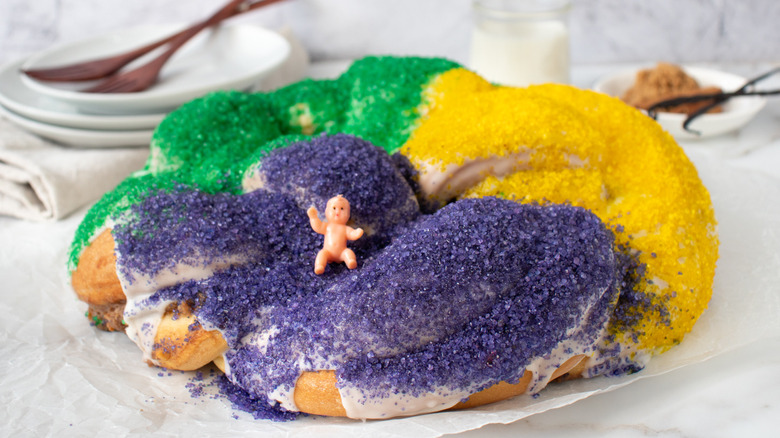
Ingredients
- 1 cup + 4 tablespoons whole milk, divided
- ¼ cup granulated sugar
- 1 teaspoon salt
- 3 ½ cups all-purpose flour, plus more for dusting
- 2 ¼ teaspoons instant yeast
- 2 eggs
- 6 tablespoons butter, melted
- non-stick spray
- ⅔ cup dark brown sugar
- 1 ½ teaspoons ground cinnamon
- 1 (8-ounce) package cream cheese, softened
- 2 cups powdered sugar
- 1 teaspoon vanilla extract
- 1 ½ cups sanding sugar (equal parts green, yellow, and purple)
Directions
- Warm 1 cup milk, granulated sugar, and salt in a medium saucepan over medium-low heat for about 3 minutes, whisking occasionally until the sugar and salt dissolve. (The temperature should be around 120 to 130 F.)
- Place the flour and yeast in the bowl of a stand mixer fitted with the dough hook attachment and stir to combine.
- With the mixer running on low speed, slowly add the milk mixture to the bowl, creating a shaggy dough.
- Once the milk is incorporated, add the eggs and melted butter and continue to mix on low for about 2 minutes until combined.
- Then, increase the speed to medium and knead for about 3 minutes until the dough begins to pull away from the sides of the bowl.
- Remove the dough from the mixing bowl, roll it into a ball, and transfer it to a large bowl lightly greased with non-stick spray.
- Cover the bowl with plastic wrap and set it aside to rest and rise for 1 hour or until doubled in size.
- Meanwhile, place the brown sugar, cinnamon, and softened cream cheese in the bowl of the stand mixer fitted with the whisk attachment and whisk until blended and smooth. Cover the bowl and set it aside.
- For the icing, place the powdered sugar, remaining 4 tablespoons milk, and vanilla extract in a medium bowl and whisk until blended. The icing should thickly coat the back of a spoon. If it is too thick, thin it out with an additional tablespoon of milk. Cover the icing and set it aside.
- Once the dough has risen, transfer it to a clean work surface lightly dusted with flour, then flatten and roll it into a 10x20-inch rectangle.
- Transfer the cream cheese filling to the dough and spread it evenly, leaving a 1-inch border around the edge.
- Fold the dough in half lengthwise, pressing around the edges to seal.
- Cut the rectangle into three even strips and braid them.
- Transfer the braided dough to a parchment-lined baking sheet and shape it into a circle, twisting and pinching the ends together to seal.
- Cover the baking sheet with plastic wrap and set it aside to rise for another hour or until doubled in size.
- Preheat the oven to 350 F.
- Once the dough has risen, place it in the oven and bake for 25 to 30 minutes or until golden brown and cooked through.
- Set it aside to cool completely on a wire rack at room temperature.
- Drizzle the cake with icing, coating as much of the surface as possible.
- Once iced, thoroughly sprinkle sections of the cake with the colored sanding sugar and top with a little plastic baby if desired.
- Set the cake aside for 10 minutes until the icing hardens, then slice and serve.
Nutrition
| Calories per Serving | 749 |
| Total Fat | 21.2 g |
| Saturated Fat | 12.1 g |
| Trans Fat | 0.4 g |
| Cholesterol | 97.9 mg |
| Total Carbohydrates | 131.2 g |
| Dietary Fiber | 2.0 g |
| Total Sugars | 87.8 g |
| Sodium | 433.1 mg |
| Protein | 10.5 g |
